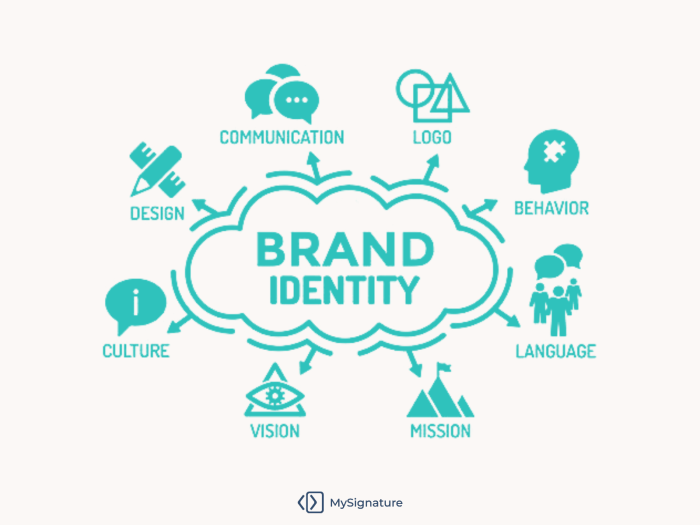Creating a Brand Identity sets the stage for businesses to establish a unique and memorable image that resonates with consumers, paving the way for long-term success. From logo design to color schemes, each element plays a crucial role in shaping how a brand is perceived in the market.
Importance of Brand Identity

Brand identity is like the swag that sets your business apart from the rest. It’s all about creating a vibe that speaks to your target audience and keeps them coming back for more.
Building Trust and Recognition
Strong brand identity helps build trust with customers. When they see your logo, colors, or messaging, they know exactly who you are and what you stand for. Think Nike’s iconic swoosh or Coca-Cola’s timeless script logo – you see it, you know it.
Influencing Consumer Perception
Brand identity plays a huge role in shaping how consumers perceive your business. Whether you’re going for a sleek and modern look like Apple or a fun and quirky vibe like Ben & Jerry’s, your brand identity sets the tone for how people view your products or services.
Driving Customer Loyalty
When customers feel connected to your brand on a deeper level, they’re more likely to stick around. Just look at Starbucks – people aren’t just buying coffee, they’re buying into the whole Starbucks experience, from the logo to the cozy atmosphere.
Elements of Brand Identity
Creating a strong brand identity involves several key components that work together to establish a brand’s image in the minds of consumers. These elements help differentiate a brand from its competitors and create a cohesive and memorable brand experience.
Logo
Logos are visual representations of a brand and are often the first thing that comes to mind when thinking about a company. A logo should be unique, memorable, and reflective of the brand’s values and personality. It serves as the face of the brand and helps consumers identify and connect with the brand.
Colors
Color plays a crucial role in brand identity as it evokes emotions and associations. Different colors can convey different meanings and elicit specific responses from consumers. Consistent use of colors across all brand materials helps in creating a unified and recognizable brand image.
Typography
Typography refers to the style, size, and arrangement of text used in branding materials. The choice of fonts can impact the readability, tone, and overall feel of the brand. Consistent typography helps in reinforcing the brand’s personality and voice.
Imagery
Images and graphics used in branding materials contribute to the overall brand identity. The style, quality, and subject matter of imagery should align with the brand’s values and messaging. Visual elements help in creating a strong visual identity that resonates with the target audience.
Voice and Messaging
The tone, language, and messaging used by a brand are essential elements of brand identity. Consistent communication style helps in establishing a brand’s personality and building trust with consumers. Voice and messaging should reflect the brand’s values and resonate with its target audience.
Branding Materials
The consistency in the use of branding materials, such as business cards, packaging, website design, and advertising, plays a vital role in reinforcing brand identity. All these elements should work together harmoniously to create a cohesive brand image that is easily recognizable and memorable.
Developing a Brand Identity Strategy: Creating A Brand Identity
Creating a brand identity strategy is crucial for establishing a strong and consistent brand image. It involves a series of steps to ensure that the brand resonates with the target audience and effectively communicates the company’s values and mission.
Steps in Creating a Brand Identity Strategy
- Conduct a thorough brand audit to assess current brand perception and positioning in the market.
- Define the brand’s unique value proposition and key differentiators from competitors.
- Develop a brand messaging framework that aligns with the company’s values and resonates with the target audience.
- Create visual elements such as logos, color schemes, and typography that reflect the brand’s personality and positioning.
- Establish brand guidelines to ensure consistency in messaging and visual identity across all brand touchpoints.
Importance of Aligning Brand Identity with Company’s Values and Mission
Aligning brand identity with the company’s values and mission is essential for building trust and credibility with customers. When the brand’s image reflects the core beliefs and objectives of the company, it creates a strong emotional connection with the target audience and fosters loyalty.
Tips to Ensure Consistency Across All Brand Touchpoints
- Develop comprehensive brand guidelines that Artikel specific rules for logo usage, color schemes, typography, and tone of voice.
- Train employees on the brand guidelines to ensure that everyone within the organization is aligned with the brand identity.
- Regularly review and update brand touchpoints to maintain consistency as the company evolves and grows.
- Solicit feedback from customers to gauge their perception of the brand and make adjustments as needed to enhance consistency.
Brand Identity Design
In the world of branding, design plays a crucial role in shaping a brand’s identity. It is through design that a brand can visually communicate its values, personality, and positioning to its target audience.
Designing a Logo
When designing a logo for a brand, it is essential to create a visual representation that effectively encapsulates the essence of the brand. This involves a strategic process of brainstorming, sketching, and refining to ensure that the final logo is not only visually appealing but also resonates with the target audience.
- Research: Conduct thorough research on the brand, its values, and its target audience to gather insights that will inform the design process.
- Simplicity: Keep the design simple and memorable to ensure easy recognition and recall.
- Uniqueness: Strive to create a logo that stands out from competitors and is distinctive to the brand.
- Scalability: Design a logo that is versatile and can be easily scaled across different mediums and platforms.
Choosing Colors, Fonts, and Visual Elements
Color, fonts, and visual elements are crucial components of brand identity design as they contribute to the overall look and feel of a brand. These elements should be carefully selected to evoke the desired emotions and perceptions in the target audience.
- Colors: Choose colors that reflect the brand’s personality and resonate with the target audience. Each color conveys different meanings and emotions, so it’s important to select them thoughtfully.
- Fonts: Select fonts that are legible, align with the brand’s tone, and enhance readability across various touchpoints.
- Visual Elements: Incorporate visual elements such as icons, patterns, or illustrations that complement the brand’s message and differentiate it from competitors.
Brand Identity Implementation

Implementing a brand identity across various platforms and marketing materials is crucial for creating a consistent and recognizable image for your brand. This involves ensuring that all visual and messaging elements are aligned to reflect the core values and personality of the brand.
Successful Brand Identity Implementations
- Apple: Apple has successfully implemented its brand identity across all touchpoints, from product design to marketing campaigns. The minimalist and sleek design, combined with the focus on innovation, has created a strong brand image.
- Nike: Nike’s iconic swoosh logo and “Just Do It” slogan are consistently used in all marketing materials, reinforcing the brand’s message of empowerment and athleticism.
- Coca-Cola: Coca-Cola’s red and white color scheme, along with its classic typography, have been maintained over decades, making it one of the most recognizable brands globally.
Challenges and Best Practices, Creating a Brand Identity
- Challenges: One of the main challenges in maintaining a consistent brand identity is ensuring that all stakeholders understand and adhere to brand guidelines. Additionally, as the brand evolves, it can be challenging to update the identity without losing brand equity.
- Best Practices: To maintain a consistent brand identity over time, it is essential to have clear brand guidelines that Artikel the use of logos, colors, typography, and messaging. Regular audits and training sessions can help ensure that all employees and partners are aligned with the brand identity.






